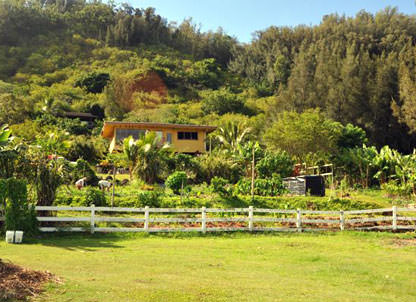
We arrived to the Pipeline Lodge in Haleiwa, Hawaii, after nightfall, greeted by cool tropical breezes and the sounds of waves caressing the shore. Waihuena Farm, operated by Meleana Judd and a team of people dedicated to sustainable agriculture on the North Shore of Oahu, runs the bed-and-breakfast that would be our short-term home away from home. Despite the 365-day growing season, the islands that compose Hawaii import more than 85-percent of all their food (and ironically, even more of their energy). Judd is out to change that, starting with 18 community-supported-agriculture shareholders who savor her fresh, local fruits, vegetables and herbs.
Our son won a National Geographic Explore Oahu essay and artwork contest, which instigated our rather unusual summer trip to the island, so we harvested our Inn Serendipity growing fields, dusted off our snorkel gear and prepared to savor papaya, mango and star fruit while staying in the cozy and spacious Pipeline Lodge overlooking both the farm and the Pacific Ocean.
Between passing rainbows, a blazing tropical sun and the occasional bursts of sheeting rain, Judd steadfastly endeavors to build up the soil and propagate perennial plants, the foundation for her permaculture-based production system. She’s still trying to figure out which systems will work on her 3 acre organic farm, a part of a larger sustainability vision for the 20-acre property owned by her family since 2007. Inspired by the deeper meanings of most Hawaiian words, Judd’s farm name, Waihuena, refers to the closest high point near the farm, reflecting her commitment to and respect for the land where she grew up.
“The whole property made my connection to the land manifest,” Meleana says. “It pulled me in. After I graduated from college in 2003 with a degree in environmental studies and started the farm in 2010, I realized that it’s not just organic farming, but a whole lifestyle that needs to be in harmony.”
Judd has received her Permaculture Design Certificate, and Waihuena Farm has already hosted its first intensive permaculture design course. She is on the front lines of Hawaii’s local-food revolution, both by keeping the country country and by restoring food security.
“If all the ocean barges stopped arriving, many of us would starve on the island,” Meleana says. Her farm’s $25-per-week CSA share is just the beginning.
Check out some of our photos capturing the beauty and productive abundance on this veritable paradise.
 This CSA share from Waihuena Farm includes papaya, kale, lemon, lime, eggplant, bananas and an avocado.
|
 Lisa and our son, Liam, wave from the spacious deck of the Pipeline Lodge, where we spent a week in paradise preparing local, fresh meals. We could also bicycle to spectacular snorkeling spots with bikes provided by Judd.
|
 Meleana Judd, owner of Waihuena Farm, is implementing permaculture principals on 3 acres of her farm in Hawaii.
|
 Waihuena Farm’s small nursery grows non-GMO papaya. Most of the other papayas on Oahu are GMO, either by choice or as a result of pollination.
|
 Waihuena Farm’s growing fields backup to the yellow farmhouse and Pipeline Lodge towers above.
|
 We savored fresh papaya nearly every day from Waihuena Farm!
|
 Farmer Mike harvests papayas by the wheelbarrow.
|
 Farmer Mike gives the “shaka” sign, meaning “hang loose” on the Hawaiian islands. It seems like everyone surfs on the North Shore.
|
 Malibar spinach is a key crop for a permaculture-designed tropical farm. “Malabar is great because it grows so well,” Judd says. “It’s yummy in raw green smoothies.”
|
 Judd steps out of the “food forest” that lines the driveway up the side of her organic farm. “It illustrates the permaculture stacking principle, using various levels,” Judd explains. “In this case, the roots are tapioca. The edible ground covers include New Zealand spinach and nitrogen-fixing ground covers, like perennial peanut, Sunn hemp and pigeon peas. The understory includes ava and ti. Then there are small temporary trees that eventually get culled out, plus papaya, banana, chaya (tree spinach), bele (edible hibiscus), and small, longer-term trees, like cacao, coffee, star fruit, citrus and curry leaf, plus vines, like Malabar spinach and lilikoi (passion fruit). And even larger trees like mac, avo, mango and michelia, which is the fragrant tree so that it entices the caregiver to visit the plants. Finally, there’s the overstory of coconuts.”
|
 The grassy area of Waihuena Farm will one day become a fresh-water pond as a part of the permaculture design for the property.
|
 Kale harvesters Blake and Ashley are part of a team of local-food enthusiasts Judd enlisted to help run the farm. Kale harvesters Blake and Ashley are part of a team of local-food enthusiasts Judd enlisted to help run the farm. |
Savoring the good life,





